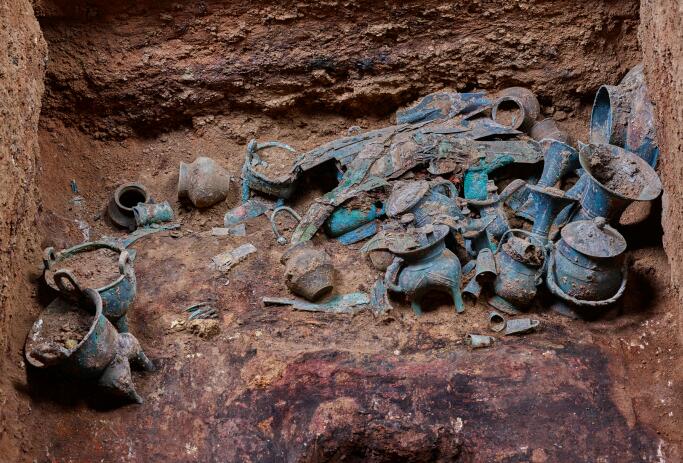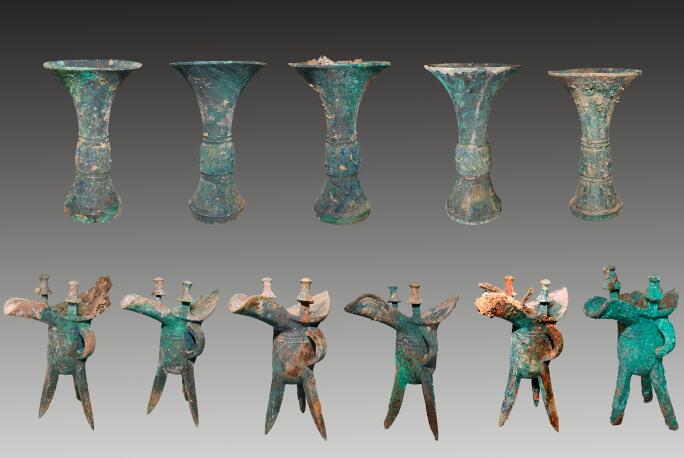High-Ranked Large Tombs of Shang Dynasty Discovered in Jiuwutou Cemetery, Shanxi Province
Jiuwutou Cemetery was located 200 meters northwest to Jiuwutou Village, Hedi Town, Wenxi County, Yuncheng City, Shanxi Province. From June 2017, Shanxi Provincial Institute of Archaeology and other institutes jointly conducted investigation in the cemetery, and implemented salvage excavation in August the same year.
Through investigation and exploration, 12 tombs, 6 horse and chariot pits and 5 ash pits of Late Shang Dynasty were discovered, while among the tombs, there were 5 large ones with burial passages, and 7 middle to small size earthen shafts pit tombs. The five large tombs (M1-M5) were all in the shape of character “甲” with passages, where the passages were either slope or step shape. The five large tombs shared great similarities in structure, the plan of which were all presented as rectangle, and four of them were all robbed, only M1 on the east side remained intact.

The bronze ware found in Tomb M1
M1 was in the shape of character “甲” with stepped passage, the plan of the chamber was rectangle, 7.2 meters in length east to west, and 5.2 meters in width from north to south, the funeral utensils was wooden with single outer and inner coffins, which had been rotten. There were three different size bronze bells Nao (musical instrument) with obvious woven reed sheet left on them, which should be the coffin board covered by the sheet. There were drum remains on the second-tiered platforms of northwest and northeast outside the outer coffin’s chamber as well as some crocodile bones. Two kinds of rotten wood black and red remains, the colorful pattern of which was indistinct, were discovered in the bottom of the coffin. There was a waist pit in bottom of the South to the middle part of the chamber, where lots of cinnabar and few bones were discovered, as well as two pieces of teeth belonging to the owner of the tomb.

Bronze ware gu-vessel and jue-drink vessel found in Tomb M1
In tomb M1 over 130 pieces of items were unearthed, which were mainly bronze, pottery, bone tools and jade ware. The bronze include ritual ware, weapon, musical instrument, chariot harnesses and other tools, and the vessel shapes were Ding Tripod, Gui vessel, Yan (steaming vessel), Gu (water vessel), Jue (wine vessel), You (water vessel), Lei (wine jar), plate, dagger-axe, spear, arrowhead, axe, knife, bow, chisel and short axe, etc; other unearthed items were pottery jar, bone tube decoration, jade fish decoration, and jade silkworm decoration. Some of the bronze possessed a family mark. The outer wall under the handle of bronze Jue had a single character family mark, and Jia and He vessels’ outer wall under the handle part had a two characters combined family mark, while there were combined carved characters under the foot ring of bronze Gu vessel, cover of the You vessel, as well as bronze bell Nao’s inner wall.

wine-vessel and drink vessel found in Tomb M1
M2 was in shape of character “甲” with slope passage, and the outer coffin’s chamber was robbed. There was a sacrificed human to the north of the tomb owner, head towards east, 1.55 m in height, in poor condition. There was a sacrificed dog on the second-tiered platform of the southwest corner, while a sacrificed dag with a neck bronze bell on the second-tiered platform of north part. Over 110 pieces of burial items were unearthed in M2, including more than 100 pieces bronze, which mainly were spear, dagger-axe, helmet decorated with monster face, arrowhead, set of tubes, and tube, etc; besides, there were jade knife, pottery jar, and other pieces, etc.
There were 7 middle to small scale earthen shaft pit tombs (M6-M12), which were all rectangle, and the remained wares were few bronze, pottery, jade, shell. Among them the bronze mainly were Ding tripod, dagger-axe, bell, arrowhead, pottery were Gui vessel, and Lei vessel etc, while jade were monster face decoration and disc.

Inscription “匿” which indicated to its state
The excavation cleared a horse and chariot pit (K1) as well, there buried one chariot, two horses, and one human. The chariot was incomplete, only chariot shaft crossbar parts and decoration, the end-pieces of axial, iron decoration on the head of a hub, decoration of the shaft crossbar, and horse decoration, etc. The human was laid on back with straight limbs, heading to east, facing south, male, height about 1.7 m. The two horses lie prostrate on the two sides of the shaft of chariot, head to east, abdomen down to earth, backbone upside. The two horses’ legs were crouched, and their necks were under chariot’s shaft crossbar, horse parietal bone was hit by blunt item. Horse and chariot wares were bronze end-pieces of axial, iron decoration on the head of a hub, monster face shaped decoration of the shaft crossbar, triangle shaped decoration on the end of shaft crossbar and decorations on the horse head, etc.
Jiuwutou Cemetery in Wenxi County was a new discovered large high-ranked noble cemetery of Late Shang Dynasty, while it was the first time discovering Late Shang Dynasty’s noble cemetery in Yuncheng Area, which was significant for the study of Late Shang Dynasty’s Yinxu Culture’s distribution range, political geography, as well as Yuncheng Area’s political position of Late Shang Dynasty. (Translator: Lang Langtian)

